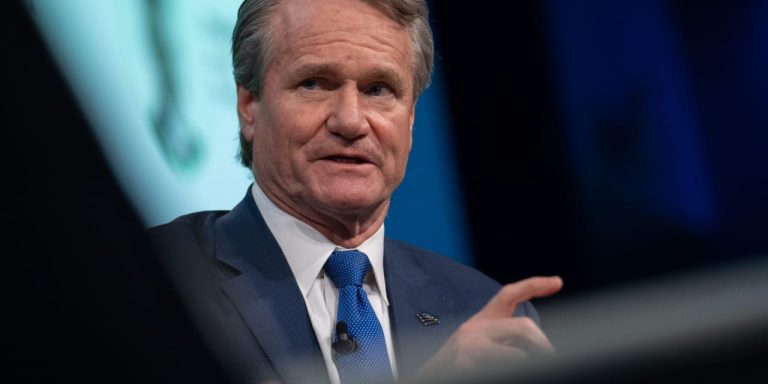Bank of America CEO Brian Moynihan.
Jeenah Moon/Bloomberg
Dreams die hard—and that goes for the dream that
Bank of America
might one day supplant
JPMorgan Chase
as America’s premier banking institution.
It wasn’t that long ago that Bank of America (ticker: BAC) seemed poised to catch, if not surpass, its more illustrious rival. Following the financial crisis, CEO Brian Moynihan doubled down on the company’s strengths, using its large deposit base to build a steady, seemingly boring institution. And it seemed to be working. Following the outbreak of Covid-19, BofA stock returned 116% for the two years ended April 1, 2022, surpassing JPMorgan’s (JPM) 70% gain. It even traded at a premium valuation, fetching 12 times 12-month forward earnings to JPMorgan’s 11.8 times.
Rising rates have changed all that. These days, BofA finds itself the problem child of big banks, perhaps more so than even
Citigroup
(C), with its sprawling, disjointed businesses constantly in need of fixes, or
Wells Fargo
(WFC), still under a consent decree. BofA trades at just 8.2 times earnings, a 15% discount to JPMorgan’s 9.6 times. The concern is the bank’s large holding of low-yielding mortgage securities, among other bonds, that have caused it to suffer unrealized losses of $105.8 billion at the end of the second quarter. Those losses likely increased by $10 billion to $15 billion during the third quarter. It’s the one issue that continues to hang over everything at the bank.
“BAC is by far the most discussed of our coverage list,” writes UBS analyst Erika Najarian. “We almost can’t believe we are here again, discussing unrealized losses on BAC’s held to maturity…securities portfolio.”
And yet that security portfolio continues to be largely responsible for how the perception of BofA has changed. Nowhere is this more clear than in the market for credit-default swaps. CDS are thought of as insurance on defaults, but in most cases, defaults are so rare that they instead serve as bets on how a company’s bonds are perceived by the market. At the beginning of 2022, five-year CDS of BofA and JPMorgan traded near 50 basis points, which means it would cost $50,000 to protect $10 million of debt. As of this past Wednesday, the cost of insuring against a JPMorgan default had risen to 63.4 basis points, while BofA had surged to 97.3—even higher than Wells Fargo at 85.5 and Citigroup at 86.7.
Bank of America says it recognizes the portfolio is an issue and has been addressing it. “You know that we’re taking the portfolio and just making it smaller,” Chief Financial Officer Alastair Borthwick said on the company’s first-quarter earnings call. “We’re taking all of that and plowing it into cash and loans.”
No one is really expecting BofA to default—it’s too big to fail, after all—but its status relative to the others has certainly fallen. BofA isn’t catching JPMorgan. Right now, it can’t even keep up with Wells and Citi.
Its earnings are coming on Tuesday, and the impact of higher rates will show up in BofA’s results. The company is expected to report a profit of 83 cents a share, up 2.5% from 81 cents during the same period the year before. That’s growth, but not much, particularly compared with, yes, JPMorgan, which grew earnings by 39%, and Wells Fargo, whose earnings rose 74%.
Bank of America, though, has a chance to redeem itself. Najarian suspects that it’s just a matter of time before the market’s focus turns from “the two Bs’’—bond losses and deposit betas, the term for how much the cost of deposits is affected by changes in interest rates—to “the two Cs,” credit and capital. Rising interest rates are already showing up in an increase in bankruptcies in recent months, and BofA’s ability to weather losses when borrowers default will go a long way to determining how well its stock performs in the year ahead.
Until then, BofA could soothe investor nerves by forecasting when net interest income, or NIL, on deposits will bottom out, if not providing actual guidance, Najarian writes. “Even if it’s too early to give numbers, a message that NII can trough in 1Q24…could buoy the stock,” she explains.
Of course, no one expects BofA stock to start working as long as yields are rising. Meanwhile, it sure does look cheap. At 8.2 times 12-month forward earnings, it’s less than a point above its financial-crisis-era trough of 7.6 times. It’s also trading at just 1.03 times tangible book value, only slightly above its Covid-era trough of 0.96 hit on March 20, 2020.
Yes, it can get worse for BofA. But just how much?
Write to Ben Levisohn at [email protected]
Read the full article here









